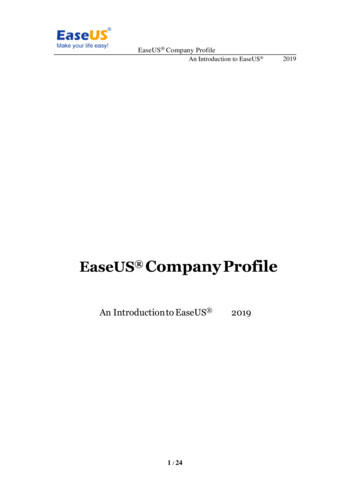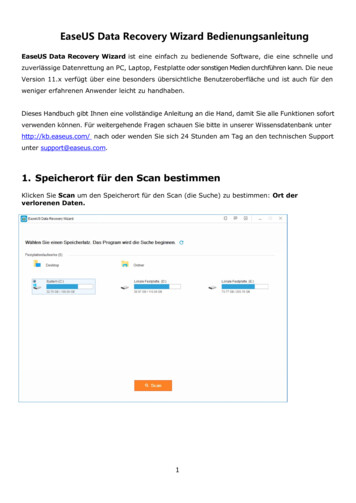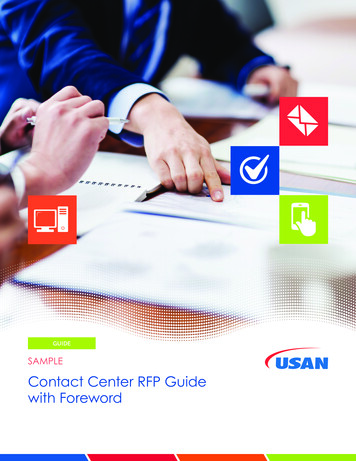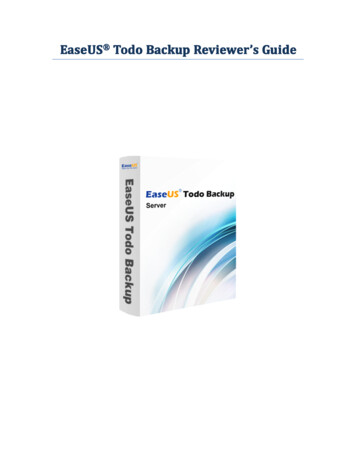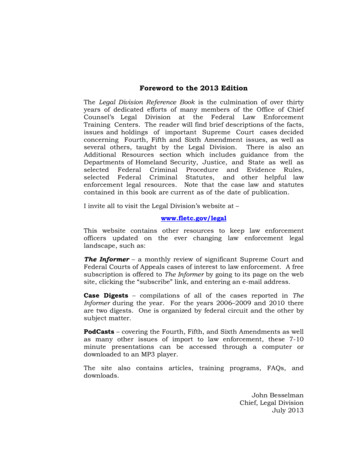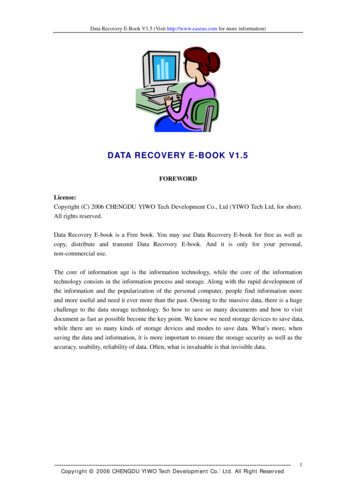
Transcription
Data Recovery E-Book V1.5 (Visit http://www.easeus.com for more information)DATA RECOVERY E-BOOK V1.5FOREWORDLicense:Copyright (C) 2006 CHENGDU YIWO Tech Development Co., Ltd (YIWO Tech Ltd, for short).All rights reserved.Data Recovery E-book is a Free book. You may use Data Recovery E-book for free as well ascopy, distribute and transmit Data Recovery E-book. And it is only for your personal,non-commercial use.The core of information age is the information technology, while the core of the informationtechnology consists in the information process and storage. Along with the rapid development ofthe information and the popularization of the personal computer, people find information moreand more useful and need it ever more than the past. Owning to the massive data, there is a hugechallenge to the data storage technology. So how to save so many documents and how to visitdocument as fast as possible become the key point. We know we need storage devices to save data,while there are so many kinds of storage devices and modes to save data. What’s more, whensaving the data and information, it is more important to ensure the storage security as well as theaccuracy, usability, reliability of data. Often, what is invaluable is that invisible ------------------------------------Copyright 2006 CHENGDU YIWO Tech Development Co.' Ltd. All Right Reserved1
Data Recovery E-Book V1.5 (Visit http://www.easeus.com for more y knowledge of data recovery.41.Connotation of data.42.The essence of data recovery .53.The scope of data recovery .54.The principle of data recovery .6Ⅱ.Data loss.61.Software reason.72.Hardware reason .7Ⅲ.Data Protecting Technologies.81.SMART Technology .82.SPS.93.DFT .94.Floppy disk array technology.95.SAN.106.NAS.107.Backup .10Ⅳ.Elementary knowledge of hard disk.101.History of hard disk development .102.Main technical specification and parameter of hard disk.123.Physical structure of hard disk .144.Logical organization of hard disk.155.Connection synopsis of hard disk .19Ⅴ.Hard disk data organization .191.Primary formatting of hard disk.192.Advanced formatting of hard disk.213.Data storage region of hard disk .23Ⅵ.Common Cases of Partition Recovery .261.MBR Recovery .262.Recovery of Partition .293.Partition Table Doctor .294.The FAT table recovery .37Ⅶ. FAT16 file system disk.391.File management in root directory of FAT16 .392. FAT16 sub-directory management .423. File deletion in FAT16.434. Contents deletion in FAT16.465. Fast high level format in FAT16 partition .466.Full advanced format in FAT16 partition .507.Searching files in FAT16 partition .51Ⅷ. Management of FAT32 file system .561.Root directory management in FAT32 ht 2006 CHENGDU YIWO Tech Development Co.' Ltd. All Right Reserved2
Data Recovery E-Book V1.5 (Visit http://www.easeus.com for more information)2. Management of sub-directory in FAT32 .613. File deletion in FAT32.634. Sub-directory deletion in FAT32 .665.High-level format in FAT32 .68Ⅸ, Management of NTFS file system .721. The NTFS file system introduction.722.NTFS file system terminology .723. Data constructions of NTFS file system .734.Drivers of NTFS.735.DBR of NTFS file system .746. Metadata of NTFS file system .777. Files and folders of NTFS partition .818. Analysis of important metafile in NTFS file system - MFT file analyzes .829. NTFS index record and contents.88Ⅹ. Dynamic disk introduction.911. Raid background .912. Realization of RAID .923. Transform basic disk into dynamic disk.934. Some terms.955.Characteristics of Dynamic disk .986. Dynamic disk management .997. RAID 0 -- Striped Disk Array .100Ⅺ.Case Study.1051. Introduction of Data Recovery Wizard 3.0 .1052. Matters needs attention before recovery .1053. Deletedrecovery .1064.FormatRecovery.1125.Recover encrypt/compressed files in NTFS.1136.RAW RECOVERY .1147. Recovery when parts of partitions are lost:.1158. Data recovery in dynamic volume .1199. Data recovery on inaccessible partition. .11910. File recovery on RAW partition .12511. Data recovery when all the partitions are lost .12512.Data recovery when GHOST Image restore failed.12913. After Partition Magic size revision/ combination/ division of partitions fails, how torecover the lost data?.12914. When using Data Recovery Wizard 3.0 to recover files, there is some strange sound inHD. How to handle it? .12915. HD cannot be detected in BIOS, how to recover data by Data Recovery Wizard 3.0 .12916. There is not enough space in hard disk to save the recovered files, nor there is removablestorage device, how to handle it? .12917. How to recover data in other storage devices (eg: floppy disk, flash drive, removable ght 2006 CHENGDU YIWO Tech Development Co.' Ltd. All Right Reserved3
Data Recovery E-Book V1.5 (Visit http://www.easeus.com for more information)18. To recover image file, how can I know it can really recover the data before I buy DataRecovery Wizard 3.0 ? .13219. There are so many files recovered, how can I find the files I want fast? .13320. I have recovered some files, but I cannot rightly open them.13521. In what occasion I cannot rightly recover data?.135Ⅻ.Introduction of data security software.136ElementaryⅠ.Elementary knowledge of data recovery1.Connotation of dataConnotation of data is comprehensive, it includes not only multi-media files such as datadocuments, images, voices that stored in file system or data base, but also hardware ht 2006 CHENGDU YIWO Tech Development Co.' Ltd. All Right Reserved4
Data Recovery E-Book V1.5 (Visit http://www.easeus.com for more information)network addresses and network services, which are used to deposit and manage those information.2.The essence of data recoveryData recovery means retrieving lost, deleted, unusable or inaccessible data that lost for variousreasons.Data recovery not only restores lost files but also recovers corrupted data.On the basis of different lost reason, we can adopt different data recovery methods. There aresoftware and hardware reasons that cause data loss, while we can recover data by software andhardware ways.Being different from prevention and backup, data recovery is the remedial measure. The best wayto insure the security of your data is prevention and backup regularly. To operate and use your dataaccording to the normative steps, you can reduce the danger of data loss to the lowest.3.The scope of data recoveryThere are so many forms and phenomenon on data problem, we can divide the objects or scope ofdata recovery according to different symptoms.System problemThe main symptom is that you cannot enter the system or the system is abnormal or computercloses down. There are complex reasons for this, thus we need adopt different processing methods.Reasons for this symptom may be the key file of system is lost or corrupted, there is some badtrack on hard disk, the hard disk is damaged, MBR or DBR is lost, or the CMOS setting isincorrect and so on.Bad track of hard diskThere are logic and physical bad track. Logic bad track is mainly caused by incorrect operation,and it can be restored by software. While physical bad track is caused by physical damage, whichis real damage, we can restore it by changing the partition or sector. When there is physical badtrack, you’d better backup your data for fear that the data can not be used any more because of thebad track.Partition problemIf partition can not be identified and accessed, or partition is identified as unformatted, partitionrecovery tools such as Partition Table Doctor can be used to recover data.Files lossIf files are lost because of deletion, format or Ghost clone error, files restoring tools such as DataRecovery Wizard can be used to recover data.Password -----------------------------------Copyright 2006 CHENGDU YIWO Tech Development Co.' Ltd. All Right Reserved5
Data Recovery E-Book V1.5 (Visit http://www.easeus.com for more information)If files, system password, database or account is lost, some special decryption tools thatcorrespond to certain data form such as Word, Winzip can be used.Files repairFor some reasons, some files can not be accessed or used, or the contents are full of troubledcharacters, the contents are changed so as they can not be read. In this condition, some specialfiles restoring tools can be tried to restore the files.4.The principle of data recoveryData recovery is a process of finding and recovering data, in which there may be some risk, for noall situations can be anticipated or prearranged. It means maybe there will be some unexpectedthings happen. So you need reduce the danger in data recovery to the lowest:Backup all the data in your hard diskPrevent the equipment from being damaged againDon’t write anything to the device on which you want to recover dataTry to get detailed information on how the data lost and the losing processBackup the data recovered in time.Ⅱ.Data lossActually, there are various reasons that cause data loss; software, hardware, factitious, natural,intended, unintended, all may cause data loss or damage on storage devices.Generally, There are two main reasons for data problem: software and hardware whosecorresponding reasons are software reason and hardware --------------------------------------Copyright 2006 CHENGDU YIWO Tech Development Co.' Ltd. All Right Reserved6
Data Recovery E-Book V1.5 (Visit http://www.easeus.com for more information)1.Software reasonVirus, format, mis-partition, mis-clone, mis-operation, network deletion, power-cut duringoperation all may be the software reasons. The symptoms are usually mis-operation, read error,can not find or open file, report no partition, not formatted, password lost and troubled characters.A: Computer Viruses: some malicious virus programs will destroy data, overwrite, or erase thedata contents.B: Mis-format: fast or completely format partition, thus changing the file system form (NTFS,FAT32) of partition.C: Mis-Clone: when backing up the hard disk, mis-clone or overlay the original data on hard disk.For these, we can use software tools to recover it. So called soft recovery means data can berecovered by software, not referring to hardware fixing operation for its fault is not because ofhardware failure.The following are prompts that system can not start up normally:Invalid Partition Table: Invalid partition table information.Missing Operating System: “55AA” mark in DOS boot sector lost or DBR corrupted.Disk Boot Failure: System file read failure.Bad or missing command interpreter: Can not find command.com file or ‘COMMAND.COM’ filecorrupted.Invalid system disk: DOS boot record corrupted.Type the name of the command, Interpreter: DOS partition mark in partition table error or‘COMMAND.COM’ file lost, corrupted.Error Loading Operating System: Main boot startup program read boot sector unsuccessfully.Not found any active partition in HDD: Active partition mark in partition table changed as inactivepartition mark.2.Hardware reasonSometimes data loss is because of hardware, such as bad sector in hard disk, power cut, headdamage, circuit panel problem, etc.When your hardware has some problems, you probably will find: the speed of hardware becomeslow, you cannot operate successfully; you cannot read data, etc, which are most often physicalbad track ----------------------------------------Copyright 2006 CHENGDU YIWO Tech Development Co.' Ltd. All Right Reserved7
Data Recovery E-Book V1.5 (Visit http://www.easeus.com for more information)Correspondingly, data recovery in hardware fix is considered as hard recovery, such as memorymedium damage, track damage, hard disk scrape, head damage, electric machinery damage, chipburnout and so on.The most distinct feature or difference between soft recovery and hard recovery is whether thememory medium itself can be normally accessed by fixing or replacing parts.Ⅲ.Data Protecting TechnologiesData security and fault freedom of storage are paid more and more attention. People are attachingmore and more importance to developing new technologies to protect data.1.SMART TechnologySMART, also called Self-Monitoring Analysis and Report Technology, mainly protects HD -----------------------------------Copyright 2006 CHENGDU YIWO Tech Development Co.' Ltd. All Right Reserved8
Data Recovery E-Book V1.5 (Visit http://www.easeus.com for more information)losing data when there is some problems on the HD. SMART drive can reduce the risk of dataloss, it alarms to predict and remind thus enhancing the data security.2.SPSShake Protecting System, can prevent the head from shaking thus enhancing the anti-knockcharacteristics of HD, avoiding damages caused by shake.3.DFTDFT, a kind of IBM data protecting technology, can check hard disk via using DFT program toaccess the DFT micro codes in hard disk. By DFT, users can conveniently check the HDoperation.4.Floppy disk array technologyOriginally ‘Redundant Arrays of Inexpensive Disks’. A project at the computer science departmentof the University of California at Berkeley, under the direction of Professor Katz, in conjunctionwith Professor John Ousterhout and Professor David Patterson.The project is reaching its culmination with the implementation of a prototype disk array fileserver with a capacity of 40 GBytes and a sustained bandwidth of 80 MBytes/second. The serveris being interfaced to a 1 Gb/s local area network. A new initiative, which is part of the Sequoia2000 Project, seeks to construct a geographically distributed storage system spanning disk arraysand automated libraries of optical disks and tapes. The project will extend the interleaved storagetechniques so successfully applied to disks to tertiary storage devices. A key element of theresearch will be to develop techniques for managing latency in the I/O and network paths.The original (‘Inexpensive’) term referred to the 3.5 and 5.25 inch disks used for the first RAIDsystem but no longer applies.The following standard RAID specifications exist:RAID 0 Non-redundant striped arrayRAID 1 Mirrored arraysRAID 2 Parallel array with ECCRAID 3 Parallel array with parityRAID 4 Striped array with parityRAID 5 Striped array with rotating parityThe basic idea of RAID (Redundant Array of Independent Disks) is to combine multipleinexpensive disk drives into an array of disk drives to obtain performance, capacity and reliabilitythat exceeds that of a single large drive. The array of drives appears to the host computer as asingle logical drive. The Mean Time Between Failure (MTBF) of the array is equal to the MTBFof an individual drive, divided by the number of drives in the array. Because of this, the MTBF ---------------------------------Copyright 2006 CHENGDU YIWO Tech Development Co.' Ltd. All Right Reserved9
Data Recovery E-Book V1.5 (Visit http://www.easeus.com for more information)a non-redundant array (RAID 0) is too low for mission-critical systems. However, disk arrays canbe made fault-tolerant by redundantly storing information in various ways.5.SANSAN, called Storage Area Network or Network behind servers, is specialized, high speed networkattaching servers and storage devices. A SAN allows "any to any" connection across the network,using interconnect elements such as routers, gateways, hubs and swithes. It eliminates thetraditional dedicated connection between a server and storage, and concept that the servereffectively "owns and manages" the storage devices. It also eliminates any restriction to amount ofdata that a server can access, currently limited by the number of storage devices, which can beattached to the individual server. Instead, a SAN introduces the flexibility of networking to enableone server or many heterogeneous servers to share a common storage "utility", which maycomprise many storage devices, including disk, tape, and optical storage. And, the storage utilitymay be located far from the servers which use it.6.NASNAS is Network Attached Storage. It can store the quick-increased information.Backup means to prepare a spare copy of a file, file system, or other resource for use in the eventof failure or loss of the original. This essential precaution is neglected by most new computerusers until the first time they experience a disk crash or accidentally delete the only copy of thefile they have been working on for the last six months. Ideally the backup copies should be kept ata different site or in a fire safe since, though your hardware may be insured against fire, the dataon it is almost certainly neither insured nor easily replaced.7.BackupBackup in time may reduce the danger and disaster to the lowest, thus data security can be mostensured. In different situations, there are different ways. Both backing up important data of systemwith hardware and backing up key information with cloning mirror data to different storage devicecan work well.Ⅳ.Elementary knowledge of hard disk1.History of hard disk developmentThe hard disk drive has short and fascinating history. In 24 years it evolved from a monstrositywith fifty two-foot diameter disks holding five MBytes (5,000,000 bytes) of data to today's drivesmeasuring 3 /12 inches wide and an inch high (and smaller) holding 400 GBytes (400,000,000,000bytes/characters). Here, then, is the short history of this marvelous --------------------------------------Copyright 2006 CHENGDU YIWO Tech Development Co.' Ltd. All Right Reserved10
Data Recovery E-Book V1.5 (Visit http://www.easeus.com for more information)Before the disk drive there were drums. In 1950 Engineering Research Associates ofMinneapolis built the first commercial magnetic drum storage unit for the U.S. Navy, the ERA110. It could store one million bits of data and retrieve a word in 5 thousandths of a second.In 1956 IBM invented the first computer disk storage system, the 305 RAMAC (Random AccessMethod of Accounting and Control). This system could store five MBytes. It had fifty, 24-inchdiameter disks!By 1961 IBM had invented the first disk drive with air bearing heads and in 1963 they introducedthe removable disk pack drive.In 1970 the eight inch floppy disk drive was introduced by IBM. My first floppy drives weremade by Shugart who was one of the "dirty dozen" who left IBM to start their own companies. In1981 two Shugart 8 inch floppy drives with enclosure and power supply cost me about 350.00. They were for my second computer. My first computer had no drives at all.In 1973 IBM shipped the model 3340 Winchester sealed hard disk drive, the predecessor of allcurrent hard disk drives. The 3340 had two spindles each with a capacity of 30 MBytes, and theterm "30/30 Winchester" was thus coined.In 1980, Seagate Technology introduced the first hard disk drive for microcomputers, theST506. It was a full height (twice as high as most current 5 1/4" drives) 5 1/4" drive, with astepper motor, and held 5 Mbytes. My first hard disk drive was an ST506. I cannot rememberexactly how much it cost, but it plus its enclosure, etc. was well over a thousand dollars. It tookme three years to fill the drive. Also, in 1980 Phillips introduced the first optical laser drive. Inthe early 80's, the first 5 1/4" hard disks with voice coil actuators (more on this later) startedshipping in volume, but stepper motor drives continued in production into the early 1990's. In1981, Sony shipped the first 3 1/2" floppy drives.In 1983 Rodime made the first 3.5 inch rigid disk drive. The first CD-ROM drives were shipped in1984, and "Grolier's Electronic Encyclopedia," followed in 1985. The 3 1/2" IDE drive started itsexistence as a drive on a plug-in expansion board, or "hard card." The hard card included the driveon the controller which, in turn, evolved into Integrated Device Electronics (IDE) hard disk drive,where the controller became incorporated into the printed circuit on the bottom of the hard diskdrive. Quantum made the first hard card in 1985.In 1986 the first 3 /12" hard disks with voice coil actuators were introduced by Conner in volume,but half (1.6") and full height 5 1/4" drives persisted for several years. In 1988 Connerintroduced the first one inch high 3 1/2" hard disk drives. In the same year PrairieTek shipped thefirst 2 1/2" hard disks.In 1997 Seagate introduced the first 7,200 RPM, Ultra ATA hard disk drive for desktop computersand in February of this year they introduced the first 15,000 RPM hard disk drive, the --------------------------------------Copyright 2006 CHENGDU YIWO Tech Development Co.' Ltd. All Right Reserved11
Data Recovery E-Book V1.5 (Visit http://www.easeus.com for more information)X15. Milestones for IDE DMA, ATA/33, and ATA/66 drives follow:1994 DMA, Mode 2 at 16.6 MB/s1997 Ultra ATA/33 at 33.3 MB/s1999
FOREWORD - EaseUS . data -----
